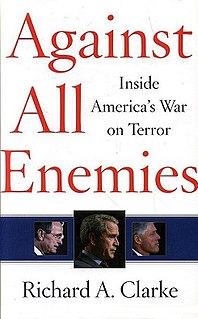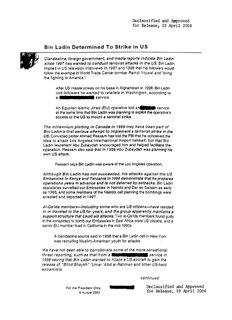Related Research Articles

Osama bin Mohammed bin Awad bin Laden, also transliterated as Usama bin Ladin, was a Saudi Arabian-born militant, mastermind behind the September 11 attacks and founder of the Pan-Islamic militant organization al-Qaeda. The group is designated as a terrorist group by the United Nations Security Council, the North Atlantic Treaty Organization (NATO), the European Union, and various countries. Under bin Laden, al-Qaeda was responsible for the September 11 attacks in the United States and many other mass-casualty attacks worldwide. On 2 May 2011, he was killed by U.S. special operations forces at his compound in Abbottabad, Pakistan.

Seymour Myron "Sy" Hersh is an American investigative journalist and political writer.

The National Commission on Terrorist Attacks Upon the United States, also known as the 9/11 Commission, was set up on November 27, 2002, "to prepare a full and complete account of the circumstances surrounding the September 11 attacks", including preparedness for and the immediate response to the attacks. The commission was also mandated to provide recommendations designed to guard against future attacks.

Richard Alan Clarke is an American national security expert, novelist, and former government official. He served as the Counterterrorism Czar as the National Coordinator for Security, Infrastructure Protection, and Counter-Terrorism for the United States between 1998 and 2003.

Against All Enemies: Inside America's War on Terror (ISBN 0-7432-6823-7) is a 2004 award-winning book by former U.S. chief counter-terrorism advisor Richard A. Clarke, criticizing past and present presidential administrations for the way they handled the War on Terrorism. The book focused much of its criticism on President George W. Bush, charging that he failed to take sufficient action to protect the country in the elevated-threat period before the September 11 attacks and for the 2003 invasion of Iraq, which Clarke feels greatly hampered the War on Terrorism. The book's title comes from the oath of office taken by all U.S. federal officials, in which they promise to defend the Constitution "against all enemies, foreign and domestic."

Bin Ladin Determined To Strike in US was the title of the President's Daily Brief prepared by the Central Intelligence Agency and given to U.S. President George W. Bush on Monday, August 6, 2001. The brief warned, 36 days before the September 11 attacks, of terrorism threats from Osama bin Laden and al-Qaeda, including "patterns of suspicious activity in this country consistent with preparations for a hijacking" of U.S. aircraft.

The Bin Laden family, also spelled Bin Ladin, is a wealthy family intimately connected with the innermost circles of the Saudi royal family. It is the namesake and controlling shareholder of Saudi Binladin Group, a multinational construction firm. Following the September 11 attacks, the family became the subject of media attention and scrutiny through the activities of Osama bin Laden, the former head of the terrorist group al-Qaeda.
Michael F. Scheuer, is an American former intelligence officer for the Central Intelligence Agency, blogger, author, commentator and former adjunct professor at Georgetown University's Center for Peace and Security Studies. One assignment during his 22-year career was serving as Chief of the Bin Laden Issue Station from 1996 to 1999. He also served as Special Advisor to the Chief of Alec Station from September 2001 to November 2004.

On October 29, 2004, at 21:00 UTC, Al Jazeera broadcast excerpts allegedly from a videotape of Osama bin Laden addressing the people of the United States; in this video, he accepts responsibility for the September 11 attacks, condemns the Bush government's response to those attacks, and presents those attacks as part of a campaign of revenge and deterrence motivated by his witnessing of the destruction in the Lebanese Civil War in 1982. News analysts speculated that the release of the video was timed to influence the 2004 U.S. presidential election, which would take place four days later.

Richard Bruce Cheney is an American politician and businessman who served as the 46th vice president of the United States from 2001 to 2009 under President George W. Bush. He is currently the oldest living former U.S. vice president, following the death of Walter Mondale in 2021.
Osama bin Laden, the founder and former leader of al-Qaeda, went into hiding following the start of the War in Afghanistan in order to avoid capture by the United States and/or its allies for his role in the September 11, 2001 attacks, and having been on the FBI Ten Most Wanted Fugitives list since 1999. After evading capture at the Battle of Tora Bora in December 2001, his whereabouts became unclear, and various rumours about his health, continued role in al-Qaeda, and location were circulated. Bin Laden also released several video and audio recordings during this time.

The One Percent Doctrine (ISBN 0-7432-7109-2) is a nonfiction book by Pulitzer Prize–winning journalist Ron Suskind about America's hunt for terrorists since September 11, 2001. On July 24, 2006, it reached number 3 on the New York Times Best Seller list.
The Path to 9/11 is a two-part miniseries that aired in the United States on ABC television on September 10–11, 2006 and in other countries. The film dramatizes the 1993 World Trade Center bombing in New York City and the events leading up to the September 11, 2001 terrorist attacks. The film was written by screenwriter Cyrus Nowrasteh, and directed by David L. Cunningham, and stars Harvey Keitel and Donnie Wahlberg.
Omar bin Osama bin Mohammed bin 'Awad bin Laden, better known as Omar bin Laden, is a Saudi-Arabian artist, author, cultural ambassador, and businessman, and fourth-eldest son of Osama bin Laden, with his first cousin and first wife Najwa Ghanhem. He has been living in Normandy, France for several years.
Osama bin Laden has been depicted or parodied in a variety of media. Notable examples include:

The September 11 attacks in the United States in 2001 were carried out by 19 hijackers of the militant Islamist terrorist organization al-Qaeda. In the 1990s, al-Qaeda leader Osama bin Laden declared a holy war against the United States, and issued two fatāwā in 1996 and 1998. In these fatāwā, bin Laden sharply criticized the financial contributions of the American government to the Saudi royal family as well as American military intervention in the Arab world.
At around 9:30 pm on September 11, 2001, George Tenet, director of the Central Intelligence Agency (CIA) told President George W. Bush and U.S. senior officials that the CIA's Counterterrorism Center had determined that Osama Bin Laden and al-Qaeda were responsible for the September 11 attacks. Two weeks after 9/11, the Federal Bureau of Investigation connected the hijackers to al-Qaeda, a militant Salafist Islamist multi-national organization. In a number of video, audio, interview and printed statements, senior members of al-Qaeda have also asserted responsibility for organizing the September 11 attacks.

On May 2, 2011, United States President Barack Obama confirmed that al-Qaeda leader Osama bin Laden had been killed in his compound in Abbottabad, northeastern Pakistan. Bin Laden's death was welcomed throughout most of the world as a fitting end to a figure who had inspired mass bloodshed, and a positive and significant turning point in the fight against al-Qaeda and related groups. Those who welcomed it included the United Nations, European Union, NATO, and some nations in Asia, Africa, Oceania, South America, and the Middle East, including Yemen, Lebanon, Saudi Arabia, India, Israel, Indonesia, Somalia, the Philippines, Turkey, Iraq, Australia, Argentina, and the rebel Libyan Republic.

The death of Osama bin Laden on May 2, 2011, gave rise to various conspiracy theories, hoaxes and rumors. These include the ideas that he had died earlier, or that he lived beyond the reported date. Doubts about bin Laden's death were fueled by the U.S. military's supposed disposal of his body at sea, the decision to not release any photographic or DNA evidence of bin Laden's death to the public, the contradicting accounts of the incident, and the 25-minute blackout during the raid on bin Laden's compound during which a live feed from cameras mounted on the helmets of the U.S. special forces was cut off.
The following is an outline of the series of events that led up the War in Afghanistan (2001–2021).
References
- 1 2 3 4 "galleycat: Bedtime for Bush". mediabistro.com. 2008-05-27. Archived from the original on 2013-01-28. Retrieved 2008-06-19.
- 1 2 3 4 Garofoli, Joe (2008-06-04). "Good Riddance Lit parodies Bush administration". San Francisco Gate. Retrieved 2008-06-19.
- 1 2 Swanson, David (2008-06-01). "Goodnight Bush". American Chronicle. Retrieved 2008-06-19.
- 1 2 3 4 Kaufman, Joanne (2008-06-16). "The Secret to Success in Publishing: Bash Bush, With Nods to a Classic". The New York Times. Retrieved 2008-06-19.